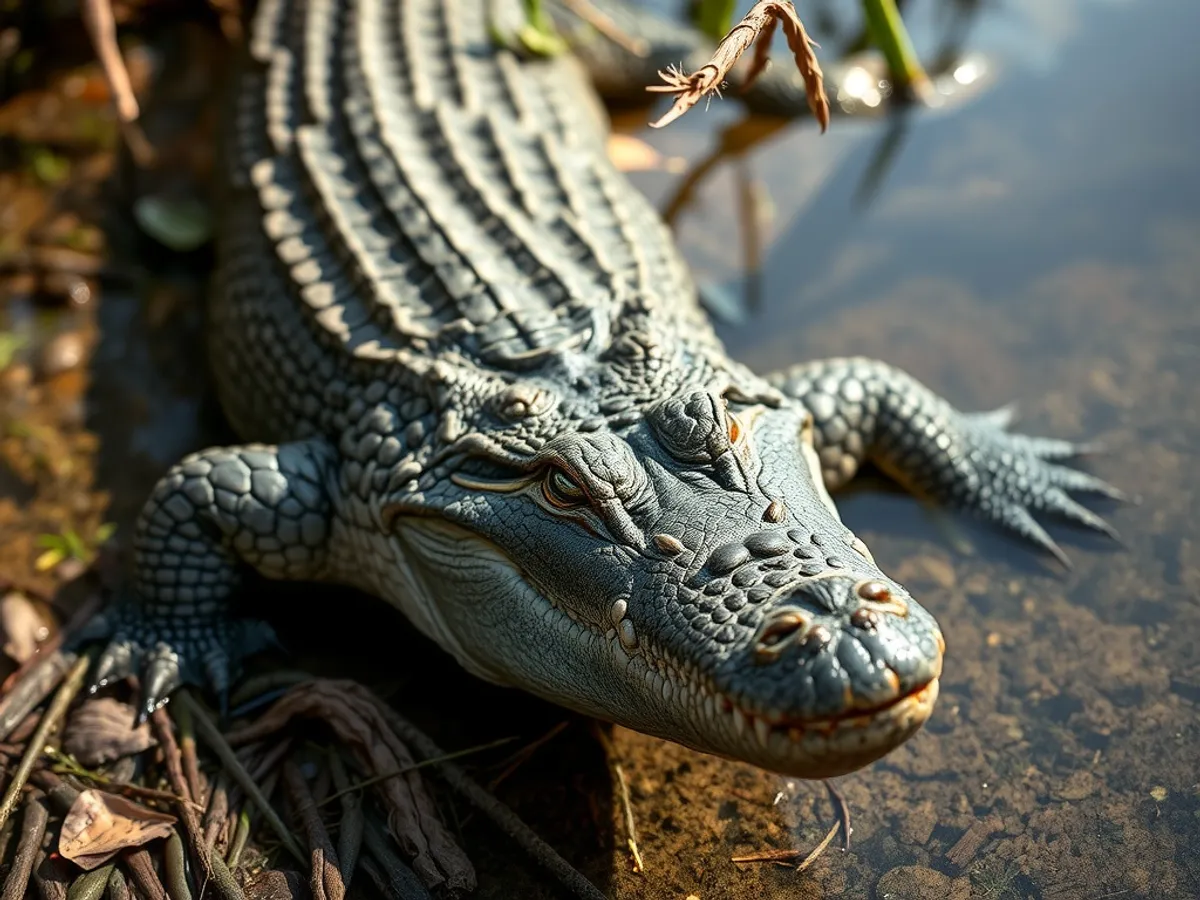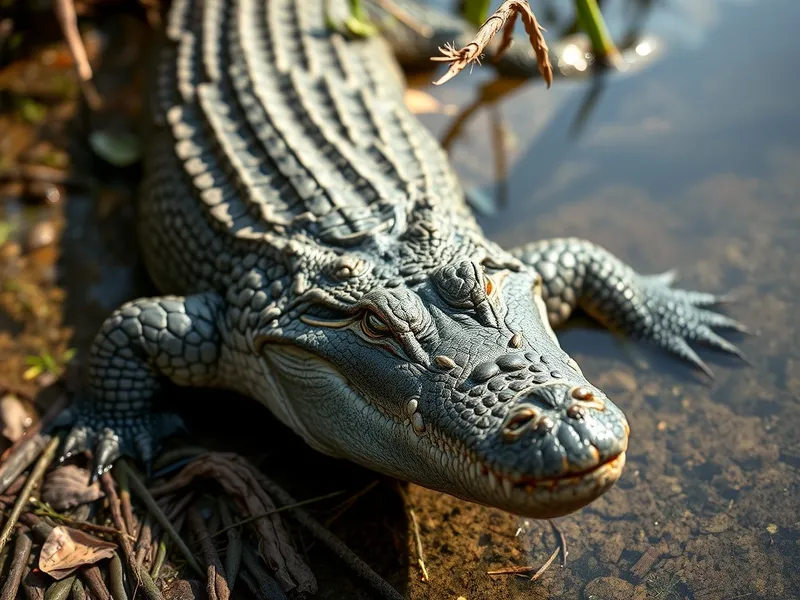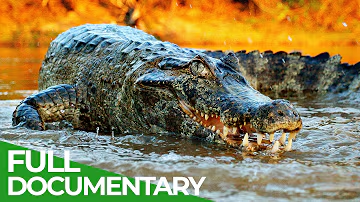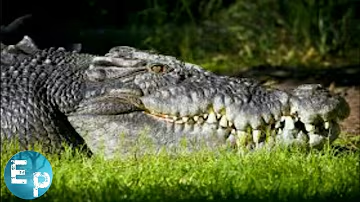
Saltwater Crocodile
Crocodylus porosus

Meet the Saltwater Crocodile
The saltwater crocodile is the largest living reptile and can be found in brackish and freshwater regions from eastern India to northern Australia. These powerful predators are known for their broad snouts, armored bodies, and immense strength, often growing up to 6–7 meters in length. Saltwater crocodiles are highly territorial and have a fearsome reputation, capable of taking down large prey, including water buffalo and even sharks. Their remarkable adaptability allows them to thrive in both saltwater and freshwater environments, making them formidable apex predators in their range.
Classification
Reptile
Habitat
Coastal wetlands, river deltas, estuaries, and mangrove swamps
Diet
Carnivore
Lifespan
70–100 years
Conservation
Least Concern
Weight
400–1,000 kg
📖Fascinating Facts
Record Size
The largest confirmed saltwater crocodile measured 6.3 meters (20.7 feet) long and weighed about 1,075 kg (2,370 lbs).
Ocean Travelers
Saltwater crocodiles have been recorded traveling hundreds of kilometers across open saltwater, aided by tidal currents.
Incredible Bite
Their bite force is estimated to be over 3,700 psi, making it the strongest bite of any living animal.
📋Detailed Description
The saltwater crocodile (Crocodylus porosus) is the largest extant reptile, with adult males commonly reaching lengths of 4.3–5.2 meters and weights of 400–1,000 kg, though rare individuals may exceed 6 meters and 1,200 kg. Females are considerably smaller, usually not surpassing 3 meters. Its robust body is armored with osteoderms, and the broad, powerful snout houses up to 68 conical teeth designed for gripping and crushing prey. The skin coloration ranges from pale yellow in juveniles to dark olive or gray in adults, often with lighter ventral surfaces. Saltwater crocodiles possess highly developed sensory organs, including pressure-sensitive pits (integumentary sense organs) on their jaws, enabling them to detect minute water vibrations. Their eyes and nostrils are positioned atop the head, allowing for stealthy ambushes while mostly submerged. Notably, they are capable of both rapid bursts of speed in water and surprisingly agile movement on land over short distances. Saltwater crocodiles are solitary and highly territorial, especially adult males, and exhibit complex dominance hierarchies. They are apex predators, preying on a wide range of animals from fish and birds to large mammals, and are known for their ability to traverse vast distances in marine environments, aided by a salt gland that excretes excess salt. Their lifespan in the wild can exceed 70 years, with some individuals living over 80 years in captivity.
💡 Did you know?
A saltwater crocodile can leap its entire body length out of the water to catch prey on low-hanging branches.
🔬Research & Sources
Wikipedia Summary
The saltwater crocodile is a crocodilian native to saltwater habitats, brackish wetlands and freshwater rivers from India's east coast across Southeast Asia and the Sundaland to northern Australia and Micronesia. It has been listed as Least Concern on the IUCN Red List since 1996. It was hunted for its skin throughout its range up to the 1970s, and is threatened by illegal killing and habitat loss. It is regarded as dangerous to humans.
Last Modified: 5/13/2025
🎭Behavior & Social Structure
Saltwater crocodiles are primarily ambush predators, relying on stealth and patience. They often remain motionless at the water’s edge, waiting for prey to approach before launching a rapid, explosive attack. Their diet is highly opportunistic, including fish, crustaceans, reptiles, birds, and mammals such as wild boar, deer, and even water buffalo. They have been documented preying on sharks and occasionally scavenging carrion. Crocodiles are mostly nocturnal, hunting at night and basking during the day to regulate body temperature. Social interactions are dominated by territoriality; adult males maintain and aggressively defend large territories, while females and juveniles occupy smaller, overlapping ranges. Vocalizations, body postures, and water slapping are used in communication, especially during territorial disputes or courtship. Juveniles are more social, sometimes forming loose groups, but adults are solitary except during the breeding season.
👶Reproduction & Life Cycle
Breeding typically occurs during the wet season (November to March in northern Australia), triggered by rising temperatures and increased rainfall. Males establish and defend territories, attracting females through vocalizations and displays. After mating, females lay 40–60 eggs in mound nests constructed from vegetation and mud, usually above the high-water mark. Incubation lasts 80–90 days, with temperature determining the sex of the hatchlings (temperature-dependent sex determination). Females guard the nest fiercely against predators such as monitor lizards and pigs. Upon hatching, the mother assists the young by carrying them in her mouth to the water. Parental care extends for several weeks, with the female remaining nearby to protect the vulnerable hatchlings. Juvenile mortality is high due to predation and cannibalism by larger crocodiles.
🛡️Adaptations & Survival
Saltwater crocodiles exhibit numerous adaptations for their semi-aquatic lifestyle. Their streamlined bodies and muscular tails provide powerful propulsion in water, while webbed feet aid in maneuvering. The presence of palatal valves allows them to open their mouths underwater without ingesting water. Specialized salt glands in the tongue enable them to osmoregulate in saline environments, a key adaptation for marine dispersal. Their integumentary sense organs detect pressure changes, facilitating hunting in murky water. The eyes have a nictitating membrane for underwater vision, and vertical slit pupils enhance low-light hunting. Their metabolism is highly efficient, allowing them to survive months without food during periods of scarcity.
📚Research Sources
🎨Cultural Significance
Saltwater crocodiles hold a prominent place in the mythology and traditions of many Indigenous cultures across their range. In northern Australia, they are revered as ancestral beings in Aboriginal Dreamtime stories and feature in totemic systems. In parts of Southeast Asia, crocodiles are symbols of power, danger, and fertility, and are sometimes associated with river spirits. Historically, crocodile skins were highly prized for leather goods, leading to extensive hunting. In modern times, they are central to ecotourism and wildlife education, but also evoke fear due to their reputation as man-eaters.
🔬Recent Research & Discoveries
Recent phylogenetic studies have clarified the evolutionary relationships within Crocodylia, confirming Crocodylus porosus as one of the most basal and widespread members of the genus. Satellite telemetry has revealed remarkable long-distance marine dispersal, with individuals traveling over 1,000 km between islands. Ongoing research focuses on salt gland physiology, population genetics, and the impacts of climate change on nesting ecology. Studies on their immune system have highlighted unique antimicrobial peptides, with potential biomedical applications. Conservation genetics is increasingly used to monitor population structure and inform management strategies.
🎥Wildlife Videos

Rivers of Death (Full Episode) | World's Deadliest
Rivers bring water, the element essential to all life. But wherever they flow, killers prowl, hidden just below the surface waiting to ...
Nat Geo Animals

Wildlife | Episode 2: Crocodiles, Alligators, Caimans & Gharials | Free Documentary Nature
Wildlife: Episode 2 - Crocodiles, Alligators, Caimans & Gharials | Wildlife Documentary Watch 'Wildlife - Episode 3: Kangaroos' ...
Free Documentary - Nature

Animal Nature Documentary - Australian Saltwater Crocodile | Wild Planet HD
Animal Nature Documentary - Australian Saltwater Crocodile | Wild Planet HD #wildplanet #crocodile #animal ...
Wild Planet

Saltwater Crocodile। Full documentary
documentary #earthpic #saltwatercrocodile #crocodile #crocodiles #crocodile_life #nature #wild #wildlife ...
Earth Pic

MonsterQuest: SUPER CROCS STALK THE EARTH (S3, E17) | Full Episode
Across the world, people are reporting increasingly frequent encounters with frighteningly large crocodiles. See more in Season 3, ...
HISTORY

Top Documentary AnimalThe giant crocodile 6 m | Animal Planet 2015 | Wildlife Documentary
Top Documentary AnimalThe giant crocodile 6 m | Animal Planet 2015 | Wildlife Documentary Top Documentary Animal.
Zoo Documentary
🌍Habitat Information
The Saltwater Crocodile typically inhabits Coastal wetlands, river deltas, estuaries, and mangrove swamps environments. Saltwater Crocodiles have adapted to their environments with specialized features and behaviors.
Primary Habitat:
Coastal wetlands, river deltas, estuaries, and mangrove swamps
More detailed habitat information will be available soon.
🛡️Conservation Status
The Saltwater Crocodile is currently classified as Least Concern. Conservation efforts are crucial for preserving this species for future generations.
Common Threats:
- 🏠Habitat loss and fragmentation
- 🌡️Climate change impacts
- 🎯Hunting and poaching
- 🏭Human-wildlife conflict
⚠️Threats & Conservation Challenges
Despite being listed as Least Concern by the IUCN, saltwater crocodiles face ongoing threats. Habitat loss due to coastal development, wetland drainage, and pollution reduces nesting and feeding grounds. Illegal hunting persists, primarily for their valuable skins and, occasionally, for traditional medicine. Human-crocodile conflict is a significant issue in some regions, leading to retaliatory killings. Climate change poses emerging risks, including altered rainfall patterns affecting nesting success and sex ratios. Conservation efforts have enabled population recovery in Australia and parts of Southeast Asia, but localized declines continue where protection is inadequate.
🔬Scientific Classification
Scientific Name
Crocodylus porosus
Classification Hierarchy
🔍 About Taxonomic Classification
Taxonomic classification is a hierarchical system used by scientists to classify and organize living organisms based on shared characteristics and evolutionary relationships.
The system moves from broad categories (Kingdom) to increasingly specific ones, with each animal's scientific name typically consisting of its Genus and species.
📝Community Notes
Share your observations and insights about the Saltwater Crocodile with our community of wildlife enthusiasts.
Join Our Community
Sign in to share your observations and connect with fellow wildlife enthusiasts.
Sign In to ContributeNo community notes yet
Be the first to share your observations about the Saltwater Crocodile!
Explore Saltwater Crocodile
Select a tab above to learn more about this amazing animal.
📸Photo Gallery
No photos available for this animal yet.
🌟Discover More Wildlife
Continue your journey of discovery with more fascinating animals from our database
